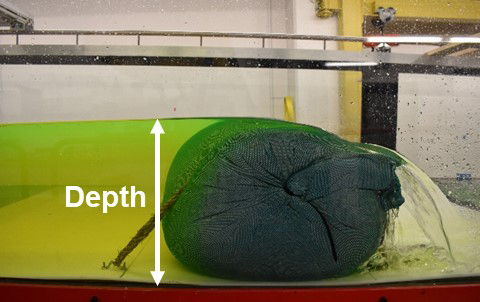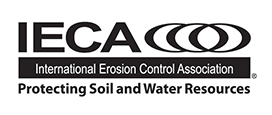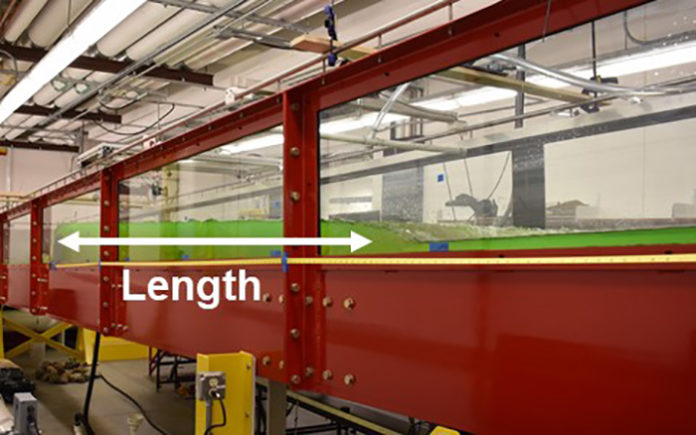By J. Blake Whitman, Ph.D., PE, CPESC; Michael A. Perez, Ph.D., CPESC; Jaime C. Schussler MS.; Lan Liu, Ph.D., LEED GA, EI
Editor’s Note: This article is an excerpted version of the IECA 2021 Technical Paper of the Year.
IECA members can read the full paper at www.ieca.org/resourcelibrary.
Introduction
Wattles are used on construction sites all over the world to manage stormwater and help reduce sediment discharge. Several research studies have focused on identifying performance metrices, such as sediment retention, when installed as a ditch check, inlet protection practice and perimeter control. A common goal among many of these studies was the development of alternative installation strategies that improve performance. While each of these studies provide valuable insight regarding wattle performance as a function of installation methodology, little information has been presented evaluating the hydraulic performance variations (i.e., subcritical flow characteristics) between wattle fill media. In 2016, Donald et al.1 developed a normalized evaluation methodology for evaluating ditch check performance based on flow characteristics; however, the methodology was contingent on several factors (e.g., channel slope, quantity of upstream cross-sections in which measurement are taken, and spacing between each cross-section) remaining consistent between tests. This research study aimed to address these limitations by presenting a normalized methodology that comprehensively evaluates the hydraulic performance of wattles using a state-of-the-art flume.
Methodology
This study used upstream subcritical flow length and impoundment depth (Figure 1) data collected in the Larry Buss Hydrology Lab Flume located at Iowa State University to quantify performance. A series of flume experiments were performed to evaluate eight wattle types that included different media fill material (e.g., excelsior, straw, coir, wood chips, synthetic and miscanthus), containment mesh (e.g., open netting and woven socking) and media density. For each wattle type, three replicable test series were performed to identify inconsistencies, if any, between datasets. Each series of tests were performed by introducing clean flow (with fluorescent dye) at four incremental flow rates (0.007, 0.021, 0.035 and 0.057 m3/s) across three channel slopes (3.50, 4.25, and 5.00%) resulting in a total of 36 tests per wattle type.2
Each wattle tested was evaluated against the control test (i.e., impervious barrier installed in lieu of a wattle) that maximized upstream subcritical flow length and minimized channelized flow velocity. High performing wattles are those that are able to reduce shear forces acting on the channel bed by increasing the subcritical flow length, or length of flow marked by high impoundment depth and low velocity. These conditions not only reduce channel erosion but are also the most advantageous in promoting settling of suspended solids. The criteria used for evaluation were (a) impoundment depth ratio, (b) subcritical length ratio, (c) independent wattle performance as a function of slope and flow rate using analysis of variance (ANOVA) and (d) statistical relevance between various matrix media materials, slopes and flow rates. The testing regime was aimed at investigating the performance of wattle fill materials across a variety of flow rates and slopes.
Ratio Analysis
Impoundment depth and subcritical length ratios were determined by comparing measured maximum impoundment depth (H2) and subcritical length (L2) values to theoretical depth (H1) and length (L1) values calculated based on wattle installation height and channel slope (Figure 2). Theoretical depth and length values are typically calculated during the design of a SWPPP to identify spacing distances for wattles installed in channelized flows. The developed ratios help normalize the relationship of measured value to theoretical value and allows comparisons to be made between wattles.
ANOVA Analysis
Two-way ANOVAs were conducted on ratio results determined for each manufactured wattle to identify if a significant performance variation occurred over the range of flow rates and slopes implemented during testing or if performance remained statically unchanged. This analysis identified how effective a particular wattle performed over a wide range of treatment scenarios.
Regression Analysis
Statistical relevance between wattle fill media was achieved by developing a multiple linear regression model. Wattle media material, slope and flow rate for each individual test were coded into independent binary variables that took values of 1 or 0, depending on whether or not a particular test included a specific media material, slope, or flow rate. Dependent variables were coded as average water depth (y) to specific energy (E) ratios.
Findings
Ratio analysis results suggest that four wattle classifications (e.g., Class 1, 2, 3 and 4) can be identified, with Class 1 being the least effective and Class 4 being the most effective at reducing supercritical flow lengths. Each class is defined by a percent difference range for depth and length ratios. Based on this classification system developed, excelsior fiber wattles fall into Class 1. Data suggest wheat straw wattles fall into Class 2 and that coconut coir, wood chips and synthetic fiber wattles fall into Class 3. The key difference between Class 2 and Class 3 wattles is the wattle’s ability to increase impoundment length while minimizing changes to impoundment depth. Class 4 wattles top out the classification system and indicate subcritical flows created by wattles are approaching optimum depth and length ratios. Miscanthus wattles were the only practices tested that fell into this classification.
The null hypotheses for the ANOVA analysis were: 1) the means of observations grouped by slope are the same, 2) the means of observations grouped by flow rate are the same and 3) there is no interaction between slope and flow rate. A significance level of 0.05 was used to determine significance. P-values less than 0.05 indicate the null hypothesis is rejected and that at least one performance ratio is significantly affected by slope or flow rate. In total, eight ANOVA tests were performed to evaluate each wattle type independently. Results from the tests suggest that: slope does not significantly impact performance ratios, flow rate does not impact performance ratios of synthetic and miscanthus wattles but does significantly impact excelsior, straw, coconut coir, and wood chip wattles, and the effects of flow rate, on performance ratios, is not dependent on slope. These findings ultimately suggest that synthetic and miscanthus wattles would be the most effective practices to install in field applications with inconsistent slope topography, while also being subjected to a wide range of flow rates.
For the regression model, the impervious weir (control) tested on a 3.50% slope and subjected to a flow rate of 0.007 m3/s was considered the base condition, against which each performance evaluation was compared. Based on the statistical significance calculated by the model, the following conclusions were drawn: 1) each media material reduced the y/E ratio, as defined by Donald et al.1, relative to the impervious weir, which was expected in the analysis, 2) coefficients for excelsior, wheat straw, synthetic fiber, wood chips and coconut coir filled wattles are statistically significant at a 95% confidence level, thus indicating significant reductions in performance compared to the impervious weir, 3) the coefficient for miscanthus fiber is not statistically significant, thus indicating negligible reductions in performance when compared to the impervious weir and 4) miscanthus fiber had the least impact on performance reduction. When comparing each of the measured performances to the impervious weir base condition, it is evident that each media material tested, as well as increasing slope, facilitates reductions in hydraulic performance.
Conclusions
Currently, there is a lack of scientifically backed data that analyzes the hydraulic performance of erosion and sediment control practices using normalized methodologies. Performance capabilities readily accessible within industry are typically published by product manufacturers and are based on ASTM standard testing methodologies,3 which can often be misleading and difficult to compare directly. This research effort sought to develop an innovative evaluation process based on hydraulic performance characteristics measured within a hydraulic flume. This study has set the stage for developing new and innovative methodologies for quantifying sediment barrier performance based on parameters previous unconsidered during evaluation processes. Using the methodologies presented herein, as well as the existing body of knowledge, groundbreaking advancements in the field of erosion and sediment control testing will certainly emerge.
About the Experts
J. Blake Whitman, Ph.D., PE, CPESC is an assistant professor in the School of Concrete and Construction Management at Middle Tennessee State University. His research efforts focus on improving the performance of construction site erosion and sediment control technologies.
Michael A. Perez, Ph.D., CPESC is an assistant professor in the Department of Civil and Environmental Engineering at Auburn University. His research efforts focus on improving construction and post-construction stormwater practices, methods and technologies.
Jaime Schussler, MS is a graduate research assistant pursuing a Ph.D. in Civil Engineering at Auburn University. Her research focuses on improving treatment efficiencies of in-channel sediment basins used on highway construction projects.
Lan Liu, Ph.D. LEED GA, EI is a former Auburn University graduate research assistant. Her research focused on the development and assessment of active and passive treatment methods for construction site sediment basins and the efficiency of sediment removal.
Acknowledgements
This paper is based on a study sponsored by the Iowa Department of Transportation. The authors gratefully acknowledge this financial support. The findings, opinions and conclusions expressed in this paper are those of the authors and do not necessarily reflect the view of the sponsor.
References
1) Donald, W.N., Zech, W.C., Fang, X., and Perez, M.A. (2016). “Hydraulic method to evaluate the performance of ditch check practices and products.” J. Hydro Eng., 21(11). Doi: 10.1061/(ASCE)HE.1943-5584.0001311.
2) Schussler, J.C., Perez, M.A., Cetin, B., and Whitman, J.B. (2020). “Field Monitoring of Erosion and Sediment Control Practices and Development of Additional Iowa DOT Design Manual Guidance.” InTrans Project 18-654, Final Report. Access on Jan. 20, 2021. https://intrans.iastate.edu/research/completed/field-monitoring-of-erosion-and-sediment-control-practices-and-development-of-additional-iowa-dot-design-manual-guidance.
3) ASTM Standard D7351 (2019). Standard Test Method for Determination of Sediment Retention Device (SRD) Effectiveness in Sheet Flow Applications. ASTM International, West Conshohocken, PA.
















